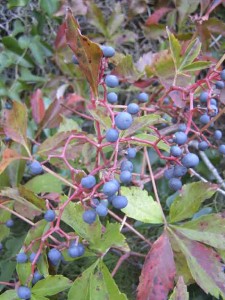Mighty fine native vine

Photo by Ken Moore. The beautiful blue berries of Virginia creeper are not edible.
By Ken Moore
Unnoticed most of the year, Virginia creeper turns the interior of many trees shades of red during the fall. It is so lush in some trees that it appears to spray over some of the outreaching limbs like a crimson waterfall.
Just a few years ago, I discovered the vine’s dark blue berries on contrasting red stems. That color combination against green and multicolored foliage increased my appreciation.
Common throughout the eastern United States, it must be sea-spray tolerant since it can be found scrambling through dune-side trees and shrubs all along the Carolina coast. As far out as the barrier island of Ocracoke, evergreen live oaks and coastal red cedars are highlighted with tints of red where this vine climbs and cascades during the fishing weeks of October.
The official botanical name is Parthenocissus quinguefolia. The genus name is derived from the Greek parthenos – virgin and cissos – ivy. Imagine several hundred years ago a botanist naming this newly discovered “ivy†from the Virginia colony in honor of the virgin Queen Elizabeth I. The species name, from the Latin quinque – five and folium – leaf, is purely descriptive of the vine’s characteristic five leaflets. Sometimes you may spot only three leaflets, so take care to search along the stems to find the more numerous characteristic five leaflets.
Enjoy remembering the botanical name; it’s great fun to hear it roll off of your tongue. It sounds like “par-thee-no-siss-us quink-a-fo-lee-ah.†Now try it out loud, and with a little practice you’re armed to surprise whoever accompanies you when you discover this vine on your next walk.
You won’t have to go far to find this member of the grape family. The berries are poisonous to humans but are enjoyed by birds that don’t think twice about dropping freshly processed seed from chimney tops, along fences and in shrubbery throughout our home gardens. Whenever I spot one volunteering, I offer it a cedar post or other type of support, looking forward to lush green summer foliage and a colorful show in the fall.
When out and about, make certain you do not confuse Virginia creeper with another common native vine with shades of red fall color. Poison ivy, Rhus radicans, is not to be touched. Remember the rhyme: “Leaves of three, let it be/Leaves of five, stay alive.†Poison ivy and Virginia creeper both have compound leaves. A compound leaf of three leaflets characterizes poison ivy, the plant with sap that makes most folks break out with a rash. Learn to distinguish it from Virginia creeper, which has palmately (like a hand) compound leaves of five leaflets. You often find these two growing together, so being familiar with their differences frees you to enjoy the beauty of both.
Like the blue berries of Virginia creeper, the little white berries of poison ivy are also cherished by birds, so poison ivy also frequently volunteers in our home landscapes. Appreciating its importance as a wildlife food, I allow poison ivy some freedom on the back edges of the garden, but I definitely don’t give it free reign over the landscape as I do the mighty fine Virginia creeper.


Comments are closed.